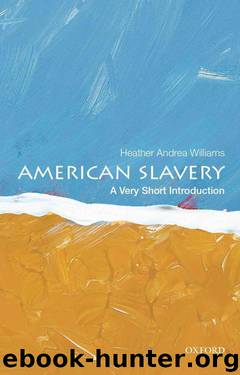American Slavery: A Very Short Introduction (Very Short Introductions) by Heather Andrea Williams

Author:Heather Andrea Williams [Williams, Heather Andrea]
Language: eng
Format: epub, mobi
ISBN: 9780199922680
Publisher: Oxford University Press
Published: 2014-07-31T21:00:00+00:00
Chapter 5
Surviving slavery
People may not have survived the hard labor and the violence, the domination and the degradation of slavery, had they not found ways of nurturing their spirits. Though they wept, they also sometimes laughed. Sometimes when they worked, they also sang, and to make the day go faster or to break up the monotony, some syncopated their work rhythms. They formed families even though legal marriage was denied them, and they had children. And when slave owners destroyed those families through sale, some people continued to love the ones whom they had lost, even as they formed new families. Most enslaved people did not escape or engage in active rebellion; instead, they focused on living their lives, resisting when they could, exerting individual agency when possible. This agency could take the form of calling a child by the name the parents chose, rather than that imposed by an owner; hunting and fishing to supplement and vary a diet of owner-issued rations; learning to read and write. People shaped their circumscribed circumstances into lives that included not only pain and suffering but also pleasure, hope, and love.
In order to survive both physically and psychically, African captives first had to figure out how to communicate with their captors, with ships’ mates, plantation owners, and other captives. They often strained to decipher other African languages and dialects, and they needed to read facial expressions and body language to unravel what Europeans wanted of them. Language adaptations began on the way to the African coast as captives passed from one community to another, sometimes spending weeks or months enslaved within Africa. Locally dialects were similar, but the farther one traveled from home, the more likely that he would be exposed to and might have to learn new ways of speaking. Then there was the shock of the coast, where African captives encountered, usually for the first time, Europeans who spoke in completely incomprehensible words and tones.
Once in America, the confusion and adaptations continued. It is difficult now to imagine how Africans and their descendants in America sounded from the early 1600s to the 1860s; their languages, dialects, and accents varied over time and place, changing as they interacted with other black people as well as with whites and Native Americans. Five of the first eleven African men who arrived in Dutch New Amsterdam in 1626—Paul d’Angola, Simon Congo, Anthony Portuguese, John Francisco, and Gracia Angola—had spent enough time among the Portuguese on the Angolan coast or on ships to have acquired Christian first names and Portuguese last names. Some of the enslaved people whose labor created the Carolina gold rice came from Barbados and carried with them the accents and words of that Caribbean island. And Sojourner Truth, who became an abolitionist and preacher, was born in a Dutch settlement in upstate New York in the 1790s and spoke only Dutch until she was sold, at age nine, to an English-speaking owner. Her inability to understand the English commands of her new mistress brought whippings for the child, so she would have quickly learned the new language.
Download
American Slavery: A Very Short Introduction (Very Short Introductions) by Heather Andrea Williams.mobi
This site does not store any files on its server. We only index and link to content provided by other sites. Please contact the content providers to delete copyright contents if any and email us, we'll remove relevant links or contents immediately.
| General | Discrimination & Racism |
Nudge - Improving Decisions about Health, Wealth, and Happiness by Thaler Sunstein(6641)
iGen by Jean M. Twenge(4703)
The Fire Next Time by James Baldwin(4348)
Adulting by Kelly Williams Brown(3678)
The Sports Rules Book by Human Kinetics(3593)
The Hacking of the American Mind by Robert H. Lustig(3586)
The Ethical Slut by Janet W. Hardy(3508)
Captivate by Vanessa Van Edwards(3304)
Mummy Knew by Lisa James(3172)
In a Sunburned Country by Bill Bryson(2951)
Ants Among Elephants by Sujatha Gidla(2927)
The Worm at the Core by Sheldon Solomon(2925)
Suicide: A Study in Sociology by Emile Durkheim(2613)
The Slow Fix: Solve Problems, Work Smarter, and Live Better In a World Addicted to Speed by Carl Honore(2577)
Humans of New York by Brandon Stanton(2382)
Handbook of Forensic Sociology and Psychology by Stephen J. Morewitz & Mark L. Goldstein(2379)
Blackwell Companion to Sociology, The by Judith R. Blau(2320)
The Happy Hooker by Xaviera Hollander(2275)
Outliers by Malcolm Gladwell(2261)
